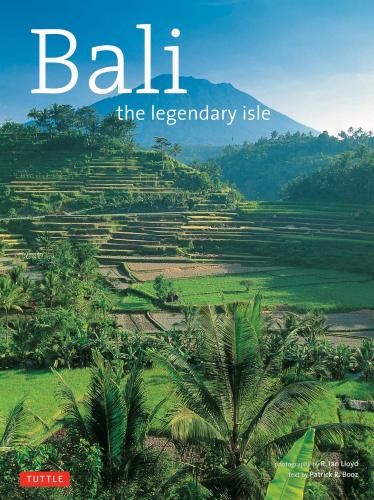A kebyar duduk dancer strikes a stylized dance position. This dance was first choreographed and performed in the 1930s.
An outrigger canoe rests on the shore of Lake Bratan in front of the important Pura Ulun Danu Bratan temple complex.
Bali
the legendary isle
photography by R. Ian Lloyd
text by Patrick R. Booz
TUTTLE Publishing
Tokyo Rutland, Vermont Singapore
Published by Tuttle Publishing, an imprint of Periplus Editions (HK) Ltd.
Paperback edition
Copyright © 2013 Periplus Editions (HK) Ltd.
Photographs © 2005 R. Ian Lloyd.
ALL RIGHTS RESERVED
No part of this book may be reproduced or transmitted in any form or by any means, electronic or mechanical, including photocopy, recording of any information storage or retrieval system, without prior written permission from the publisher
ISBN: 978-1-4629-1421-0 (ebook)
16 15 14 13 4 3 2 1 1309CP
This volume is a revised and expanded edition of Exciting Bali (962-593-210-0) and Bali: A Travel Portrait (962-593-082-5).
Printed in Singapore
Distributors
Asia Pacific Berkeley Books Pte Ltd
61 Tai Seng Avenue #02-12, Singapore 534167
Tel: (65) 6280 1330; Fax (65) 6280 6290
Indonesia PT Java Books Indonesia
Kawasan Industri Pulogadung
Jl. Rawa Gelam IV No.9, Jakarta 13930
Tel: (62) 21 4682 1088; Fax: (62) 21 461 0206
Japan Tuttle Publishing
Yaekari Building 3rd Floor, 5-4-12 Osaki
Shinagawa-ku, Tokyo 141 0032
Tel: (81) 3 5437 0171; Fax: (81) 3 5437 0755
North America, Latin America & Europe
Tuttle Publishing
364 Innovation Drive, North Clarendon
VT 05759-9436
Tel: 1 (802) 773 8930; Fax: 1 (802) 773 6993
The kecak dance is a spectacular sight as it is performed by a large troupe of at least 50 men chanting in rhythm.
Terraced sawah (rice fields) are found throughout Bali, wherever water is available from spring-fed streams.
Surfboards for rent on Kuta beach. An American named Robert Koke is credited with introducing the sport to Bali in the late 1930s.
The Amandari resort, located just outside Ubud, was designed along the lines of a Balinese village. The open-air lobby was designed after a village meeting place, or wantilan.
The Pura Besakih temple complex is over half a mile (one kilometer) long and consists of 22 temples.
Contents
An Island Unto Itself
The island of Bali is just one of the thousands of islands in the Malay Archipelago—that great chain that straddles the equator from New Guinea to the tip of Sumatra and once, eons ago, formed a land bridge between Asia and Australia. Yet unlike the other islands, Bali has held sway in the world’s imagination for most of the past century. Bali’s special reputation came about for several reasons, but to the visitor its allure and fascination are clear and immediate. The island is physically beautiful and the people, lithe, graceful and full of friendliness, exude a quiet confidence.
To the Balinese, their island is the entire world. Other worlds may exist outside, but theirs is complete and whole in itself, a total provider, bountiful with all the physical and spiritual attributes important to existence. In fact the Balinese cosmos is so rich that the psychic, unseen world is constantly spilling over into the mundane. Daily life is a constant expression of the need to honor, praise and propitiate gods and nymphs, demons and witches. Hardly a day goes by without a procession or temple festival, and at night villages far and wide come alive to opera and dance-drama, accompanied by the strange, hypnotic music of gamelan percussion orchestras. To an outsider, Balinese life seems to be a continuous celebration with brief intervals for rest.
According to legend, Bali originated as a special event during the creation of the universe. Through the purity of meditation, the phenomenal world emerged, magnificently arrayed, layer upon layer, from the base of the cosmos below to the perfumed heavens above. In between, the island of Bali appeared, resting on an immense turtle afloat in a vast ocean.
The scientific explanation of the island’s birth and development is a wonderful story as well. Once connected to the massive Asiatic mainland, Bali became an island after the melting of the polar ice caps nearly 120 million years ago. Bali is considered the last outpost of mainland Asia, separated by a 1,000-foot (300-meter) deep channel from the island of Lombok to the east. This channel also represents an ecological boundary known as the Wallace Line after the 19th-century naturalist Alfred Russel Wallace. He noted that Bali has luxurious vegetation and animals found on the Asian mainland such as elephants, tigers, monkeys and wild cattle, while Lombok and the islands to the east suggest an affiliation with Australia and not Asia. Here , east of the Wallace Line, the climate is more arid and the vegetation thorny and scrub-like. The animals include marsupials, the world’s largest lizards, parrots and cockatoos, and relatively few insect species.
